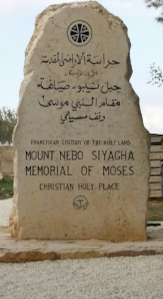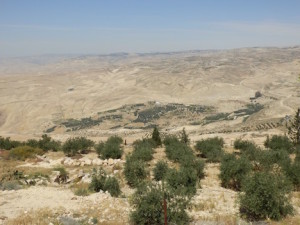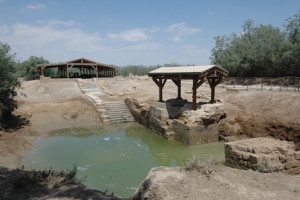Sometime around, oh, 3300 years ago, Moses leaned out from Mt. Nebo in Jordan – as I just did a few days ago – and looked over into the Promised Land. Paul VI, St. John Paul II, and Benedict XVI made a point of going there as well. Because from that commanding height, the panorama of subsequent religious history, a history we still remember as no other, is spread out: from the Dead Sea in the South to the Sea of Galilee in the North, with Jericho in the center (a city in Moses’ day already 8000 years old), and just beyond, Jerusalem.
Poor Moses. He faced down Pharaoh, kept the stiff-necked Israelites together (more or less) for forty years in the desert, and even came down from Mt. Sinai with the Ten Commandments. But was forbidden to go any farther. He died and was buried, somewhere unknown, on Mt. Nebo.
 All because of some slight lack of faith – learned rebbes disagree exactly what – in how he followed God’s instructions to draw water from a rock. (Numbers 20:18-20) A cautionary tale for all of us of weak faith.
All because of some slight lack of faith – learned rebbes disagree exactly what – in how he followed God’s instructions to draw water from a rock. (Numbers 20:18-20) A cautionary tale for all of us of weak faith.
Only in the desert does it really become clear how essential water is to life. And to fundamental things you don’t see when you believe water is merely something that comes out of a tap.
We’re partly clay (earth + water) – and partly a spirit breathed into clay by the Spirit. But even before it comes to that, without water, earth is sterile, hard stone or shifting sand. That earth can be beautiful, very beautiful indeed, like the rank upon rank of stark mountains and valleys north of Mt. Nebo. But it’s an inhuman, lunar landscape that drives people to look elsewhere for something we sense within ourselves, something more like us.
Below Mt. Nebo, on a still fertile plain where various crops grow, much as they must have in Biblical times, lies Bethany-beyond-the-Jordan, the place where John the Baptist baptized Jesus. (Jn. 1:28) We will commemorate the birth of Jesus in a few days, but we know very little about his life after that (the notable exception: his disputes with the doctors in the Temple) until he comes to be baptized by John in the Jordan. All four Gospels agree: it was after that initiation through water and the Spirit, that Our Lord began the mere three years of his “public life,” three years that it would be an understatement to say altered human history.
All (except John) also say he went into the desert for forty days – recapitulating the journey of the Chosen People – and was tempted there by the Devil with the usual things: what I would call mere physical satisfactions, spiritual presumption (tempting God), political power. Something akin to our current materialisms, “spirituality,” and salvation via politics. Jesus didn’t fall for any of them. He overcame them, without, as we know only too well from the world around us, taking them entirely away.
And all this was near Jabel Mar Elias (“two arrow shots away from the river” according to an early pilgrim), the hill where Elijah, after himself dividing the waters of the Jordan, like Moses during the Exodus, was taken up into heaven by a fiery chariot.
All things flow, as the Greek philosopher Heraclitus put it. Even the course of the Jordan has changed, as meandering rivers will do, over the millennia. The river now is maybe ten meters wide, when it once was several times that width according to the archeologists.
But some things – the far more important things – do not pass away. In fact, they introduce something new, over and above even geological processes. The great civilizations of the Eastern Mediterranean emerged close to rivers: Mesopotamia (literally the land between the two great rivers, the Tigris and the Euphrates), and the green ribbons along the Jordan and the Nile. It’s from these fragile strips of life that some of the most momentous currents of human history have flowed, and continue.
Multiculturalism pretends all “cultures” are equal, in theory; in practice, it is not so. Nothing like the three great religions of the Middle East – Judaism, Christianity, Islam – emerged from Africa or the Americas or even Europe. Hinduism and its offshoot Buddhism have had a deep hold over the large population of the Indian subcontinent, and a few other places. Beautifully, as Zen, in Japan. Little elsewhere. Confucianism and Taoism have had a long, if uneven, run in China.
But the great spiritual outflow, the one where various currents met and mingled in the plains beyond the Jordan, is like nothing else.
It’s still a highly contested region as well, of course, today more so than at any time in the recent past. Until a truce in the 1990s between Israel and Jordan, the area around the site of Jesus’ baptism was literally a minefield. Baptisms are now being performed there again, but the Jordanian visiting area is carefully marked – the rest is still a controlled military zone. On the Israeli side, just yards away, there were Ethiopian Orthodox baptisms going on yesterday – presided over by heavily armed Israeli forces and three flags: the state of Israel, the Israeli Army, and the border patrols.
The Prince of Peace came into the world and began his saving action in this land. But we have his word: “Do not suppose that I have come to bring peace to the earth. I did not come to bring peace, but a sword.” (Mt. 10:34) We shouldn’t be surprised that our divisions last until He comes again.
We use many images to suggest the multiple dimension of that saving action: the Rock – the unchanging Way, the Truth, and the Life – from whose side flowed the saving blood and water.
















